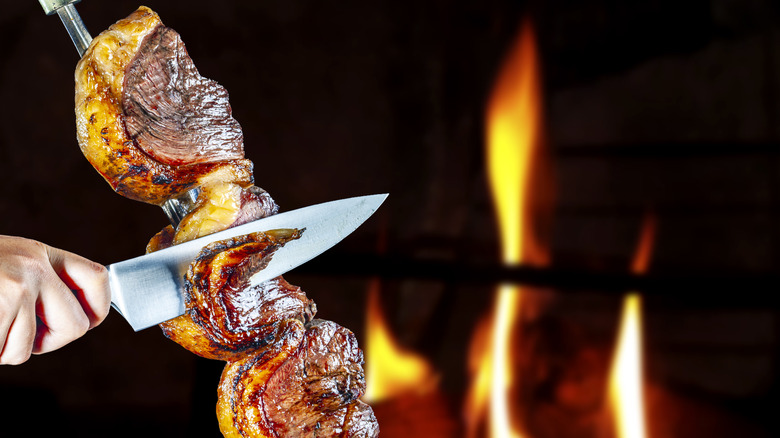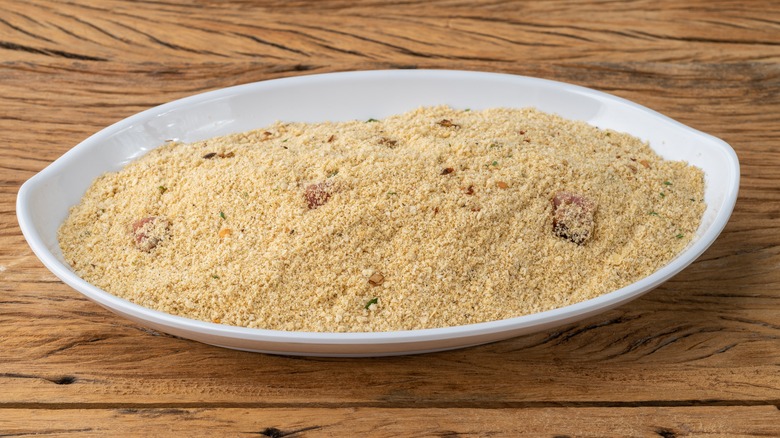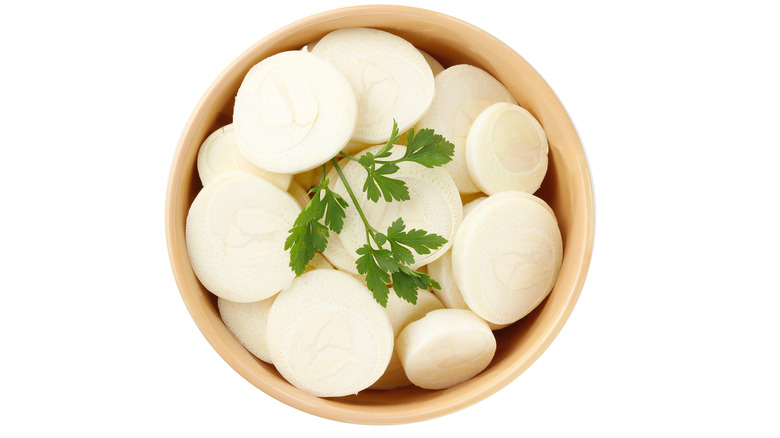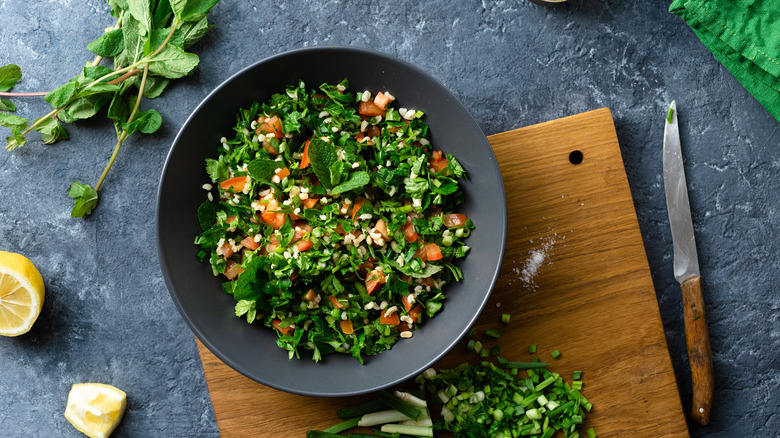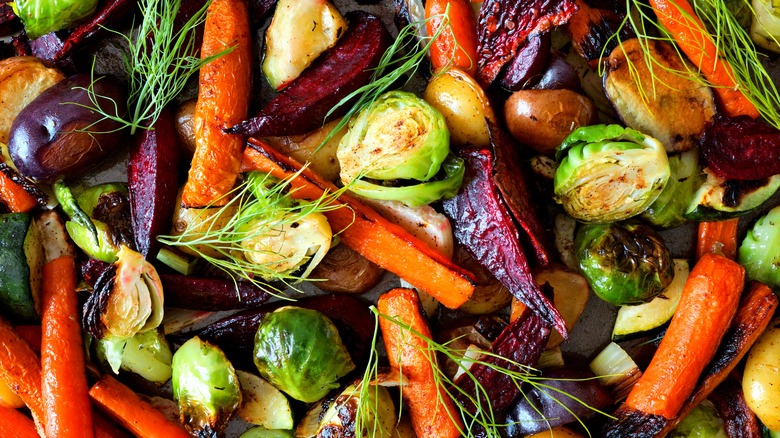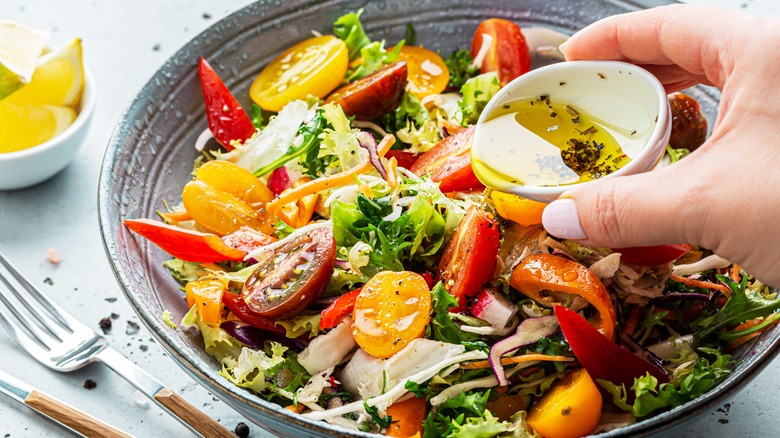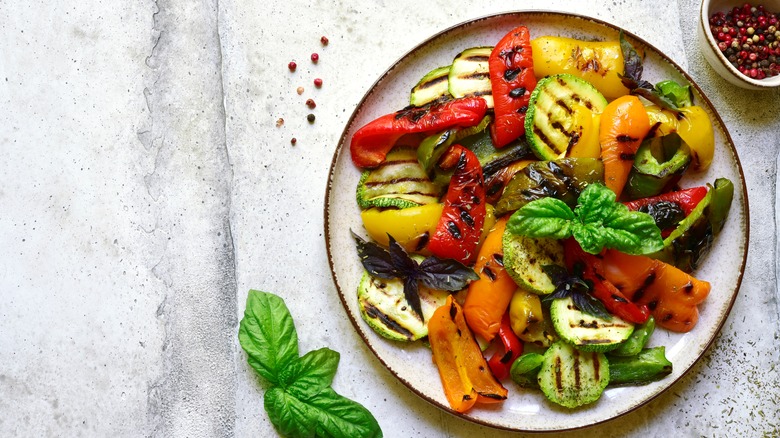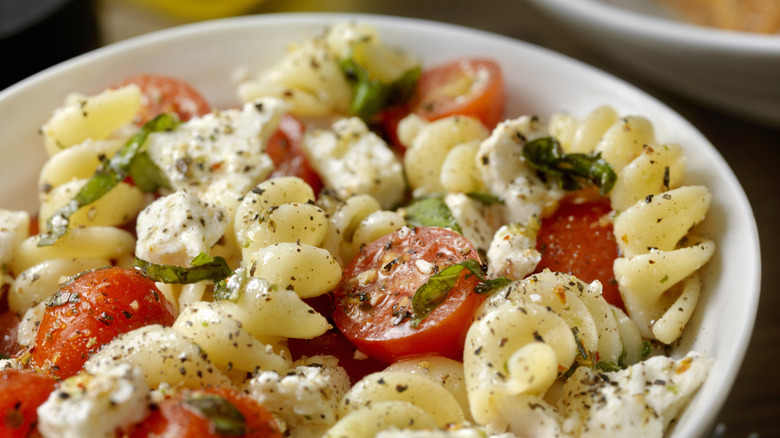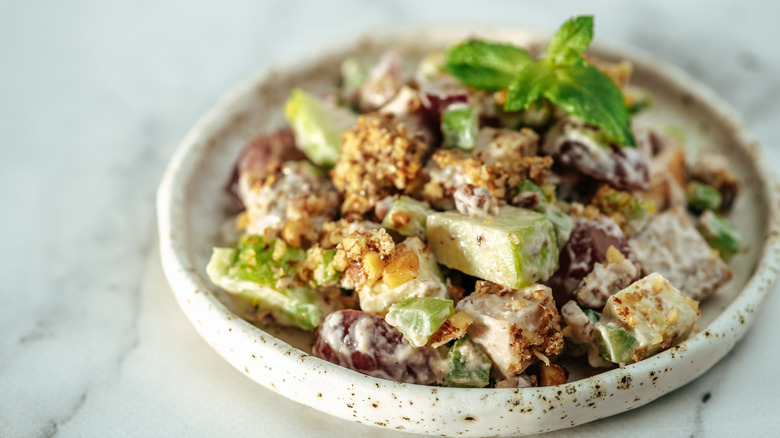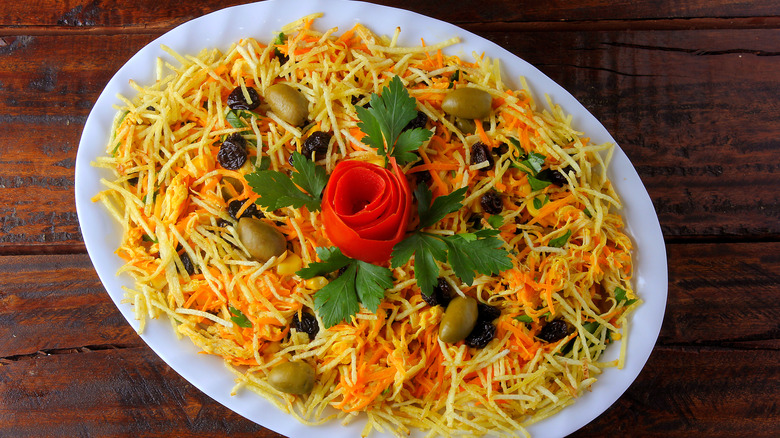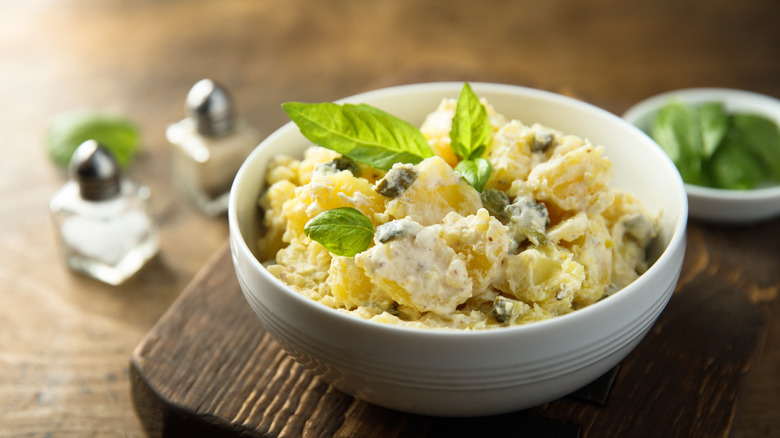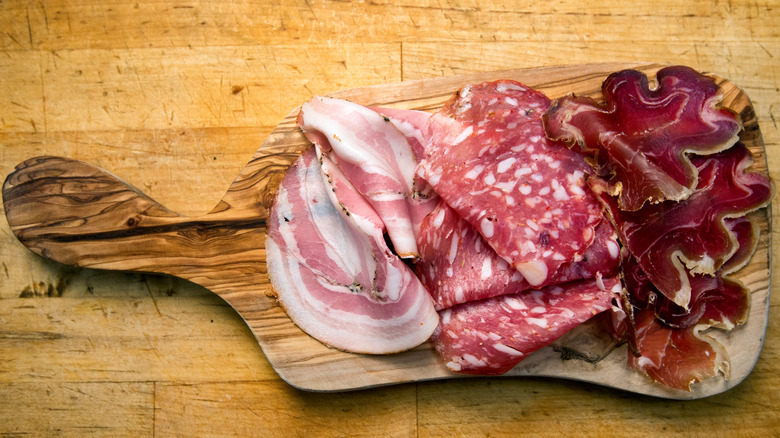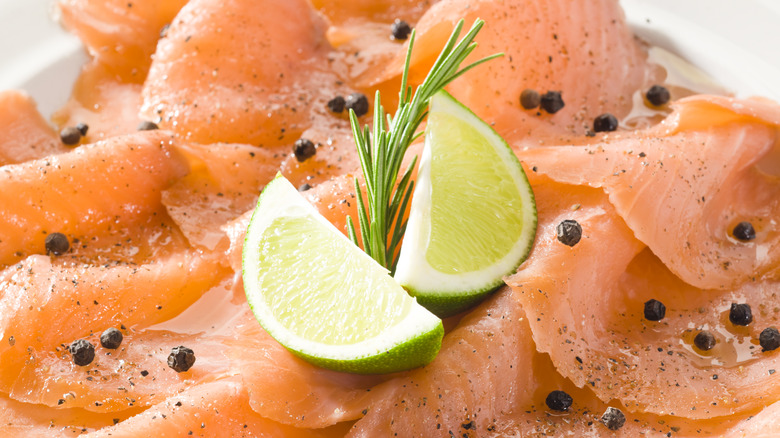12 Things You Should And Shouldn't Eat At A Brazilian Steakhouse Salad Bar
Most Brazilian steakhouses function in the so-called rodizio style in which large skewers of meat done on the grill are immediately brought to guests' tables, where the waiter then slices pieces directly onto people's plates. This is usually a long dining affair, consisting of numerous courses featuring different cuts of meat, including beef, pork, lamb, and sausages. And though these massive meat skewers make the backbone of every respectable Brazilian steakhouse, the lavish salad bars are a definite bonus to the whole experience.
Though they are usually referenced as salad bars, the options go far beyond the typical greens and toppings. Often, these sections include various cold cuts, cheeses, side salads, relishes, pickles, and seafood specials. Sometimes, the number of options can be overwhelming, and the all-you-can-eat approach often tempts diners to indulge. The most common mistake people can make is to try to sample everything at the salad bar, which leaves them filling up on sides before the first grilled skewer of succulent meat arrives at the table. We're here to help you better understand the process and learn how to effortlessly navigate all the offerings at these seemingly excessive steakhouse salad bars so that you can get the most out of the experience.
Should: Farofa
Farofa is a quintessential Brazilian dish typically served as an accompaniment with various main courses. You will usually see it partnered with feijoada — a traditional bean stew — as well as with rice and different grilled meats. Naturally, it often finds a home at those lavish salad tables at Brazilian steakhouses.
Essentially, farofa is toasted cassava flour, though some variations will use corn or other types of flour. Cassava, also known as manioc, is mainly cultivated for its starchy root used to make flour. To make farofa, flour is fried in fat, usually butter or oil, until it attains a distinctive toasty character. Traditional farofa is often made with onions and garlic, but adding specks of bacon, sausages, or bananas is also fairly common. Farofa can vary in texture, but it usually has a powdery or crumble-like consistency.
Farofa can be made into a sweet side, but the savory version is the one you will most often find at a steakhouse. It will usually be served in a communal bowl at the bar, so you can decide how much to get. If you start your meal with feijoada, which is also pretty standard at Brazilian steakhouses, you can sprinkle some farofa on top. Otherwise, reserve a pile on your plate so you can add a dash to each bite of grilled meat that will be gracing your plate. Farofa will perfectly accentuate all those roasted flavors and give you a true taste of Brazil.
Should: Hearts of palm
Hearts of palm are another uniquely Brazilian item you will find at steakhouse salad bars. As you may guess, this is an ingredient harvested from the center of certain palm trees, more precisely, from the center of the stem. Hearts of palm may be relatively unfamiliar internationally, but in Brazil and other parts of Latin America, they are often served as a side dish or a convenient snack. They are sometimes labeled as palmito or chonta.
In the rare case that you come across freshly harvested hearts of palm, they can be eaten raw, but in a more likely scenario, hearts of palm will be preserved in brine and sold in cans or jars. The briny version is most likely what you'll find at steakhouse salad bars. The whole heart of palm has an elongated, tube-like shape, but it can be sliced into smaller pieces before serving. The pieces have an off-white color and a firm, crunchy texture that is easy to bite through. The flavor is relatively mild and is best described as a mix of sweet and sour notes.
Because hearts of palm will preserve some of the acidity from the brine, they make an ideal partner with protein and fat-laden steakhouse meats. They can also be a great palate cleanser between various courses.
Should: Tabbouleh
Tabbouleh is not an original Brazilian creation. This mixed salad hails from Lebanon and has long been a staple in several Middle Eastern countries. But some time ago, it was introduced to Brazil by Lebanese immigrants. It quickly found a home there, so you will often see it featured at Brazilian steakhouses.
Traditionally, tabbouleh is a salad packed with chopped mint, parsley, diced tomatoes, onion, and bulgur. The combination is generously coated in a mix of olive oil and lemon juice and seasoned with salt. As you may guess, this is a salad with a fresh, aromatic, and zesty kick that will surely wake up all the taste buds. It is an ideal option to pair with the hefty chunks of grilled meat because the bright lemon acidity and all those herbal flavors can easily cut through the somewhat overpowering fattiness of grilled steaks. Tabbouleh should always be served chilled, which also works great to balance the heat from the steaks just off the grill.
Tabbouleh has a strong character, and it can easily be the only accompaniment with meat, but it is also versatile enough to pair with other sides and treats from the salad bar.
Should: Any seasonal option
If you are bewildered by the sheer number of options at the salad bar of a typical Brazilian steakhouse, the easiest way to maneuver through them and get the most out of the experience is to go seasonal. A large portion of the steakhouse salad bar does not depend on seasonal offers. You will always find things like charcuterie boards, various cheeses, pasta or couscous salads, assorted pickled veggies, fruit, and the famed feijoada. However, there is also typically a seasonal selection that should be your go-to choice if you are unsure about other options. If it is the peak of summer, go for that caprese salad that will most likely have perfectly ripe and juicy tomatoes, or choose the crisp asparagus when they are in the season in the spring.
Seasonal eating is generally encouraged as a wise dietary approach as it ensures that the food that you are eating is fresh and flavorful. The fruit and veggies in season are often sourced locally, meaning that they are sold fully ripened as they hit their peak. Even from a nutritional perspective, seasonal and freshly picked produce will keep most of its nutrients intact.
Should: Greens that you can dress up to taste
Though meat plays a central role at Brazilian steakhouses, most people will want to reach for something less heavy to start the meal or lighter side options to partner with the meat. If the pre-mixed salads are not your thing, or you doubt their freshness, the best choices are the fresh veggies, preferably a variety of mixed greens. There are usually several options, and you can easily customize your plate by adding the ones that best suit your taste. Then all you have to do is spruce them up with a dressing of choice.
You will often see steakhouses claiming that salad dressings are made in-house. This means there is probably no need to question their freshness. It's also likely that some attention has been put into making them. You can usually choose from among several dressing varieties, or mix them up if that is your style. The best part is that you can easily control the amount you put on your veggies. This way, you avoid overly sauced salads or wilted greens in the pre-mixed options. You also get a salad that perfectly fits your taste, and all those greens will remain firm and crisp.
Should: Roasted or grilled veggies
Along with other delicacies, most salad bars at Brazilian steakhouses will feature at least one, but usually several, roasted or grilled veggie options. These include universal favorites such as zucchini, eggplant, jalapeños, asparagus, roasted peppers, and artichoke hearts. Onions and garlic are also regulars. The dishes are usually a part of the hot section of the table.
Roasted or grilled veggies are a great option when you want to partner something lighter with grilled meat, or if you want to make sure that you do not go overboard with all the protein. The veggies are less heavy than the meats, but the two share similar flavor characteristics. You can expect plenty of roasty and smoky flavors, which complement each other well. If there are plenty of roasted dishes to choose from, follow the previous advice and go for seasonal options. There is nothing better than grilled zucchini packed with ripe sweetness at its peak in the summer months.
Should not: Pasta salads
Many steakhouses include pasta salads among the salad bar offerings. On their own, these can be great meals, but at a typical steakhouse, there should be no home for them on your plate. You are better off skipping them in favor of other, lighter, and less filling options. Pasta salads are typically served in the chilled section, and though there is no set recipe or a list of ingredients, you will typically see cooked pasta smothered in creamy, mayo-based sauces.
The problem with pasta salads has nothing to do with their flavor or freshness — these salads will not wilt under heavy dressings like greens will. The issue here is the amount of mayonnaise that is usually used as the base. Mayonnaise is a fatty, calorie-rich food that should be eaten sparingly, and in pasta salad, it is one of the dominant ingredients. After adding in the pasta and other fixings, you end up with a hearty dish that can make a meal in its own right. And perhaps a pasta salad might be the ideal lunch option, especially during the summer when you are craving something chilled and simple. But it does not fit in a typical steakhouse's narrative. It will quickly fill you up before the main players of meat even hit the table. Skip this option, and allow the meat to be the star of the show.
Should not: Waldorf salad
The Waldorf salad is one of the best-known American sides. This timely dish has its origins at the Waldorf Astoria Hotel in New York City. As the story goes, Oscar Tschirky, who worked as maître d'hôtel at the Waldorf, was the one who invented it, initially with a combination of celery, apples, and mayonnaise. Different variations were created over time, and these days you will often see grapes and walnuts added to the mix. Though Waldorf salad is an absolute classic, it would be best to skip it if you see it at a steakhouse salad bar.
Like pasta salads, Waldorf salads can be quite heavy due to the addition of mayonnaise. It is also one of the pre-mixed options, so you never know how long it has been sitting in the salad bar, allowing the celery and apple to soak up all the moisture and turn into soft mush. Since Waldorf is one of those salads that must deliver crunch, this is potentially a huge risk. Save the Waldorf for your next visit to an elegant bistro and have it before or with your main course. Those types of restaurants will probably execute a much better version than any spots serving these pre-mixed salads buffet style. And you'll be saving room for more of that amazing meat.
Should not: Salpicão de frango (Brazilian chicken salad)
Many steakhouses include Brazilian chicken salad as an option. Also known as salpicão de frango, this Brazilian dish combines tender shredded chicken pieces with various vegetables, such as carrots and corn, all doused in a creamy mayo-based dressing. The salad is then topped with crispy potato sticks, also known as batata palha, and can be served with rice. As you may assume, this salad raises concerns similar to the previous two items on the list.
Salpicão de frango is not one of those light side salads. It is a filling dish packed with calories, and as it already has meat inside, it would be a strange partner to smoky steaks and other grilled meats. You could choose it as a meal starter, but it will easily make you full and probably stop you from enjoying all the meat that is supposed to come later.
Should not: Potato salad
Potato salad is one of those universal dishes that transcends cultures, countries, and borders. Though it can come in various forms, a typical potato salad will incorporate sliced or diced potatoes cooked until tender and doused in a creamy, usually mayonnaise-based, dressing. Potato salads are usually well-executed — it is really hard to mess up this classic — but the main reason you should skip it lies in the calorie count. All the elements inside the salad are relatively filling. The potatoes are starchy, and the dressing is usually laden with fatty mayo. If you are dining at a Brazilian steakhouse, you're better off choosing a lighter option to pair with the grilled meat — especially if you are planning to indulge in more than one or two options.
Another unfortunate thing with this salad is its pre-mixed feature. Any good potato salad will be made ahead, giving the potatoes enough time to absorb all the flavors from the dressing, but it can be a tricky option when it comes to ensuring freshness. You do not want the potatoes to be an unappetizing mush.
Should not: Charcuterie
Charcuterie is technically not a salad, but you will often see hefty boards decorated with cold cuts among the versatile offerings at a typical Brazilian steakhouse. These boards may sometimes even be partnered with a generous cheese selection. Though many love charcuterie boards — mainly because they are aesthetically pleasing and a great sharing option — you should probably skip the urge to reach for the nicely assembled sliced meat when dining at a Brazilian steakhouse.
It's difficult to resist the charcuterie board, but no matter how little you take, this is absolutely unnecessary since you have a series of sizzling hot grilled meat options coming your way. And, let's be honest, you will probably not eat that prosciutto or ham on its own. You'll want to combine it with one of the many available sauces or relishes. Cheese is a natural pairing with charcuterie as is bread — and you can easily guess where this is going. Grabbing even a few pieces from that charcuterie board to eat can easily lead to a steakhouse catastrophe where you will quickly fill up. You might even have to skip some meat courses. But that's the whole reason you are there. Generally, it's best to ignore the charcuterie board altogether.
Should not: Seafood sides
Brazilian steakhouses are meat temples. Various cuts of meat skewered and grilled to perfection are the specialty and the main reason why everyone flocks to these legendary restaurants. However, seafood is not an unfamiliar item. The salad bars often feature items such as ceviche, smoked salmon, or shrimp salads.
These are not necessarily bad options on their own, but they are certainly not the best items to choose at places specializing in grilled meat. Seafood is not their prime business, so there is always a reasonable risk that less emphasis is put on the quality of ingredients and the execution.
The only time that seafood would be acceptable at a Brazilian steakhouse is if you refrain from meat or are perhaps not allowed to eat meat for various reasons. Essentially, it is commendable that these places have some seafood options, but those should not be the focus for customers looking to enjoy the rodizio experience. Reserve the shrimp salad for your favorite seafood restaurant, and enjoy what the steakhouses are best at — serving copious amounts of premium, flawlessly grilled meat.
